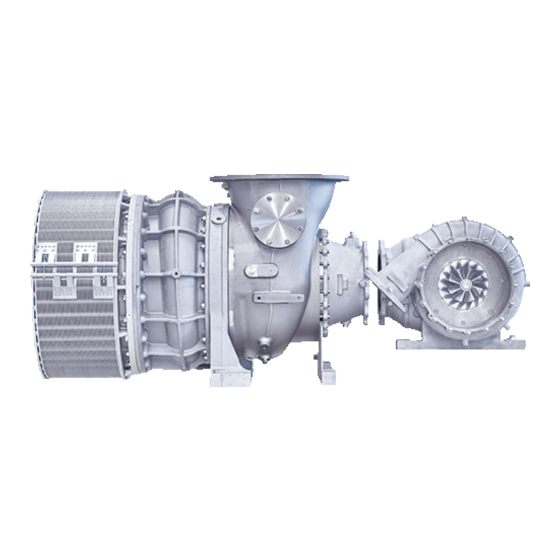
ABB Power2 340-H44 Manuals
Manuals and User Guides for ABB Power2 340-H44. We have 11 ABB Power2 340-H44 manuals available for free PDF download: Operation Manual
ABB Power2 340-H44 Operation Manual (124 pages)
Low-pressure stage
Brand: ABB
|
Category: Industrial Equipment
|
Size: 13.03 MB
Table of Contents
-
-
Fig. 210
-
Fig. 311
-
Safety16
-
Introduction16
-
Intended Use18
-
Oil Supply38
-
Table 1343
-
Table 1443
-
Speeds44
-
Service Work49
-
Table 1653
-
Table 1754
-
Introduction68
Advertisement
ABB Power2 340-H44 Operation Manual (124 pages)
Brand: ABB
|
Category: Industrial Equipment
|
Size: 13.03 MB
Table of Contents
-
-
Fig. 210
-
Fig. 311
-
Safety16
-
Introduction16
-
Intended Use18
-
Oil Supply38
-
Table 1343
-
Table 1443
-
Speeds44
-
Service Work49
-
Table 1653
-
Table 1754
-
Introduction68
ABB Power2 340-H44 Operation Manual (116 pages)
Brand: ABB
|
Category: Industrial Equipment
|
Size: 13.29 MB
Table of Contents
-
-
Safety16
-
Introduction16
-
Intended Use18
-
Table 1242
-
Oil Supply43
-
Table 1448
-
Table 1548
-
Speeds49
-
Service Work54
-
Table 1758
-
Table 1859
-
Introduction71
-
Spare Parts99
-
Table 55101
-
Table 56102
-
Table 57103
-
Table 58104
-
Table 59105
-
Table 60106
-
Table 61107
-
Table 62108
-
Table 63109
-
Table 64110
-
Table 65111
-
Tools112
Advertisement
ABB Power2 340-H44 Operation Manual (116 pages)
Brand: ABB
|
Category: Industrial Equipment
|
Size: 13.29 MB
Table of Contents
-
-
Safety16
-
Introduction16
-
Intended Use18
-
Table 1242
-
Oil Supply43
-
Table 1448
-
Table 1548
-
Speeds49
-
Service Work54
-
Table 1758
-
Table 1859
-
Introduction71
-
Spare Parts99
-
Table 55101
-
Table 56102
-
Table 57103
-
Table 58104
-
Table 59105
-
Table 60106
-
Table 61107
-
Table 62108
-
Table 63109
-
Table 64110
-
Table 65111
-
Tools112
ABB Power2 340-H44 Operation Manual (116 pages)
Brand: ABB
|
Category: Industrial Equipment
|
Size: 13.28 MB
Table of Contents
-
-
Safety16
-
Introduction16
-
Intended Use18
-
Table 1242
-
Oil Supply43
-
Table 1448
-
Table 1548
-
Speeds49
-
Service Work54
-
Table 1758
-
Table 1859
-
Introduction71
-
Spare Parts99
-
Table 55101
-
Table 56102
-
Table 57103
-
Table 58104
-
Table 59105
-
Table 60106
-
Table 61107
-
Table 62108
-
Table 63109
-
Table 64110
-
Table 65111
-
Tools112
ABB Power2 340-H44 Operation Manual (116 pages)
Brand: ABB
|
Category: Industrial Equipment
|
Size: 13.29 MB
Table of Contents
-
-
Safety16
-
Introduction16
-
Intended Use18
-
Table 1242
-
Oil Supply43
-
Table 1448
-
Table 1548
-
Speeds49
-
Service Work54
-
Table 1758
-
Table 1859
-
Introduction71
-
Spare Parts99
-
Table 55101
-
Table 56102
-
Table 57103
-
Table 58104
-
Table 59105
-
Table 60106
-
Table 61107
-
Table 62108
-
Table 63109
-
Table 64110
-
Table 65111
-
Tools112
ABB Power2 340-H44 Operation Manual (116 pages)
Brand: ABB
|
Category: Industrial Equipment
|
Size: 13.29 MB
Table of Contents
-
-
Safety16
-
Introduction16
-
Intended Use18
-
Table 1242
-
Oil Supply43
-
Table 1448
-
Table 1548
-
Speeds49
-
Service Work54
-
Table 1758
-
Table 1859
-
Introduction71
-
Spare Parts99
-
Table 55101
-
Table 56102
-
Table 57103
-
Table 58104
-
Table 59105
-
Table 60106
-
Table 61107
-
Table 62108
-
Table 63109
-
Table 64110
-
Table 65111
-
Tools112
ABB Power2 340-H44 Operation Manual (116 pages)
Brand: ABB
|
Category: Industrial Equipment
|
Size: 13.28 MB
Table of Contents
-
-
Safety16
-
Introduction16
-
Intended Use18
-
Table 1242
-
Oil Supply43
-
Table 1448
-
Table 1548
-
Speeds49
-
Service Work54
-
Table 1758
-
Table 1859
-
Introduction71
-
Spare Parts99
-
Table 55101
-
Table 56102
-
Table 57103
-
Table 58104
-
Table 59105
-
Table 60106
-
Table 61107
-
Table 62108
-
Table 63109
-
Table 64110
-
Table 65111
-
Tools112
ABB Power2 340-H44 Operation Manual (116 pages)
High-pressure stage
Brand: ABB
|
Category: Industrial Equipment
|
Size: 13.29 MB
Table of Contents
-
-
Safety16
-
Introduction16
-
Intended Use18
-
Table 1242
-
Oil Supply43
-
Table 1448
-
Table 1548
-
Speeds49
-
Service Work54
-
Table 1758
-
Table 1859
-
Introduction71
-
Spare Parts99
-
Table 55101
-
Table 56102
-
Table 57103
-
Table 58104
-
Table 59105
-
Table 60106
-
Table 61107
-
Table 62108
-
Table 63109
-
Table 64110
-
Table 65111
-
Tools112
ABB Power2 340-H44 Operation Manual (116 pages)
High-pressure stage
Brand: ABB
|
Category: Industrial Equipment
|
Size: 13.29 MB
Table of Contents
-
-
Safety16
-
Introduction16
-
Intended Use18
-
Table 1242
-
Oil Supply43
-
Table 1448
-
Table 1548
-
Speeds49
-
Service Work54
-
Table 1758
-
Table 1859
-
Introduction71
-
Spare Parts99
-
Table 55101
-
Table 56102
-
Table 57103
-
Table 58104
-
Table 59105
-
Table 60106
-
Table 61107
-
Table 62108
-
Table 63109
-
Table 64110
-
Table 65111
-
Tools112
ABB Power2 340-H44 Operation Manual (116 pages)
High-pressure stage
Brand: ABB
|
Category: Industrial Equipment
|
Size: 13.29 MB
Table of Contents
-
-
Safety16
-
Introduction16
-
Intended Use18
-
Table 1242
-
Oil Supply43
-
Table 1448
-
Table 1548
-
Speeds49
-
Service Work54
-
Table 1758
-
Table 1859
-
Introduction71
-
Spare Parts99
-
Table 55101
-
Table 56102
-
Table 57103
-
Table 58104
-
Table 59105
-
Table 60106
-
Table 61107
-
Table 62108
-
Table 63109
-
Table 64110
-
Table 65111
-
Tools112
Advertisement










